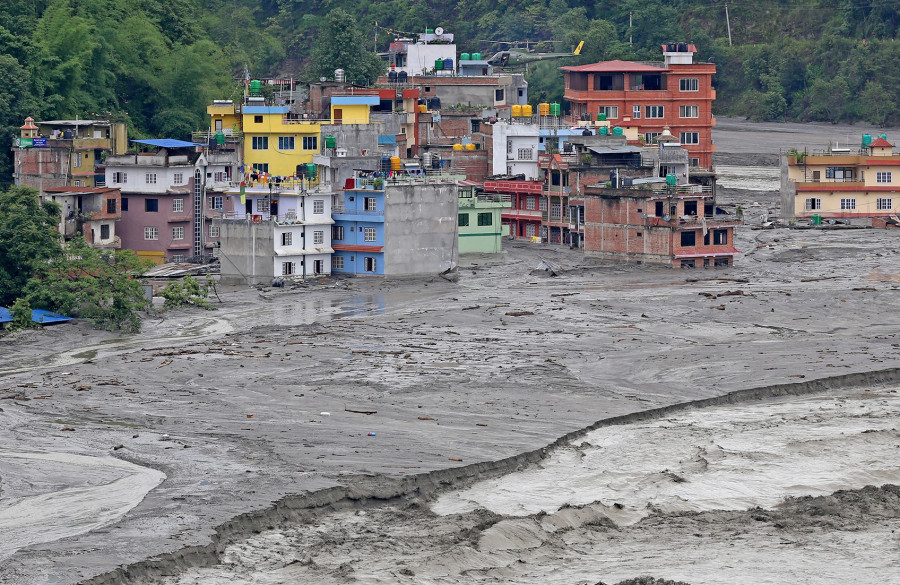Columns
Ways to ease climate crisis
Restoring abandoned local ponds can replenish rainwater and recharge local springs.
Santosh Nepal
The time has come to recognise that we are living in the midst of a climate crisis. According to the World Meteorological Organisation, the last seven years have been the warmest on record. In 2021 alone—a year when the average global temperature reached more than 1 degree Celsius above pre-industrial levels—record-breaking extreme weather events linked to climate change occurred around the world. Assuming the form of severe flooding, heat waves and droughts, such episodes resulted in thousands of deaths.
The recently released UN Intergovernmental Panel on Climate Change (IPCC) Working Group II report highlighted that many economic sectors are already being adversely affected by climate change, particularly as it relates to water availability. One of the IPCC report’s main highlights is that adaptation becomes less effective with more warming. For example, it is reported that water-related adaptation is most effective for a temperature change of up to 1.5 degrees Celsius, but that the efficacy of adaptation measures—such as changes in cropping patterns and crop systems—will become small or negligible under scenarios whereby the average global temperature rises more than 2 degrees Celsius above pre-industrial levels.
Unusual natural hazards
Many regions in Nepal have also experienced unusual natural hazards and disasters recently. The Melamchi disaster in June 2021, for example, involved a combination of extreme rain, landslides, flooding and sedimentation. Such compound extreme events can create cascading impacts in mountains. The Melamchi disaster illustrated that such catastrophes can occur within a “system”, whereby one hazard can trigger another and the cumulative impact can be much greater than that of a single hazard. Going forward, the tightening grip of climate change on Nepal could signal that disasters like Melamchi are likely to become more frequent in the Nepal Himalaya.
Beyond floods, Nepal is also very vulnerable to drought. In recent years, drought has impacted many sectors, especially the highly water-dependent agriculture sector. Farmers have indicated that winter crops are very sensitive to changes in winter precipitation. Given that winter and spring precipitation constitutes about 15 percent of annual precipitation, heightened precipitation variability can cause a severe impact on winter crop production.
One of the most visible impacts of such changes is that there has been less snowfall in high altitude areas recently. When snow does not remain for a long time, soil moisture is not maintained for winter and spring crops. Climate change will exacerbate such drought conditions which, in turn, may trigger other socio-economic challenges, such as loss in agricultural productivity and rural migration to urban areas.
Despite high per capita water availability in Nepal, the country is yet to utilise its water resource potential to the fullest to transform socio-economic development. One primary challenge is that water resources are typically managed via a sectoral approach, rather than a holistic approach.
Sectoral silos can create unwarranted barriers and difficulties in terms of making the best use of water resources for socio-economic development. Moreover, vulnerable groups including women, children and marginalised communities bear the consequences of ineffective water management. Currently, water requirements for ecosystems are neglected to a large extent, especially where water is utilised for other purposes in the upstream region.
Solutions across scales
Nepal is yet to fully operationalise Integrated Water Resources Management (IWRM) as directed by the 2002 Nepal Water Strategy, 2005 National Water Plan and 2021 National Water Policy. The Bagmati River Basin Improvement Project is the first attempt to put the concept of IWRM into practice, as it includes a river basin organisation with adequate capacity and a decision support system. While IWRM can serve as an overarching guiding framework, we can also mobilise other water management approaches (depending upon the local context), such as the water-energy-food-ecosystem nexus, integrated flood and drought management, nature-based solutions, enhanced water productivity and local-scale water use master planning. These specific approaches can be better suited to solving water management challenges on multiple scales, from farm level to the river basin level.
In Nepal’s new federal structure, local governments have power and roles in dealing with problems in their jurisdictions. Drying up of springs is a major concern at the local level. Thankfully, local governments can now take decisive action on rejuvenating drying springs and ponds by controlling anthropogenic activities such as deforestation and haphazard rural road construction, and conserving local water resources. Equally important is the restoration of abandoned local ponds, which can play a crucial role in replenishing rainwater and recharging local springs. Better access to water resources for local communities including marginalised communities and vulnerable groups not only supports local livelihoods, but also helps reduce migration driven by water scarcity.
Understanding the characteristics, quantity and trends related to available natural resources allows us to make more informed, evidence-based decisions. While we often boast about Nepal’s abundant water resources, the reality is that we cannot afford to average too much or too little water availability at different times of the year. Instead, we need to figure out how to store and utilise excess water from the monsoon season during the dry season. While artificial water storage facilities can help with excess water storage during the rainy months, we also need to consider natural storage options like groundwater, soil moisture and wetlands. Nepal also needs reliable data and information so that such quantified information can be quickly and easily accessed at multiple scales. The continuous monitoring of natural resources can help us gain a better sense of their status and overall health, and support sustainable management options.
Various organisations have piloted different approaches to resolve water-related problems at various scales across Nepal. Going forward, solutions that have been tested and validated at a particular place need to be scaled out to a similar ecological region, and a proof-of-concept must be developed. Only once such tested interventions are replicated in many places can the solutions serve a bigger population through upscaling. But we must be cautious: Rushing to replicate the responses without first demonstrating a proof-of-concept can be short-sighted and counterproductive.
Nepal has a tremendous opportunity to utilise its natural resources and contribute to its overall socio-economic development. Given the challenges posed by climate change and other socio-economic changes, however, Nepal is most likely to achieve this transformation by considering the multiple benefits of water, energy, food and ecosystem sectors in collaboration with multiple stakeholders across scales.




 7.12°C Kathmandu
7.12°C Kathmandu















